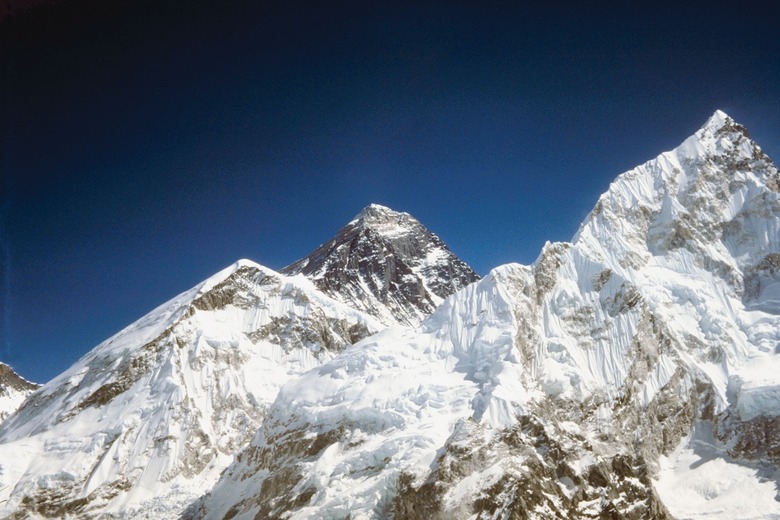Description Of Plate Tectonics & How It Explains The Distribution Of Tectonic Activity
The Earth may seem like a static thing, but in truth it is dynamic. The Earth has gone through massive changes since its formation, thanks in part to plate tectonics. In some parts of the world it is common for the ground to shift and shake, toppling buildings and creating huge tsunamis. The ground may split, pouring forth molten rock, smoke and ash that darkens the sky for hundreds of miles. Even the mountains, which seem timeless, are slowly growing in some ranges. The theory that describes all of these processes and explains why they occur when they do is called plate tectonics.
Plate Tectonics
Plate Tectonics
The Earth's crust is made up of large, irregularly shaped slabs of rock called tectonic plates that float atop a subsurface ocean of heated liquid rock called magma. In some regions of the world, particularly on the ocean floor, there are areas where the plates are spreading apart. As they spread, magma bubbles up and hardens, creating new continental crust.
In other areas, different tectonic plates are sliding toward each other. The motion of tectonic plates colliding, separating or just sliding along next to one another is responsible for a range of tectonic activities including earthquakes, volcanoes and the formation of mountains.
Plate Boundaries And Earthquakes
Plate Boundaries And Earthquakes
When tectonic plates grind along one another they create earthquakes. Areas like this are called transform plate boundaries. For example, the well studied San Andreas fault in North America runs from the Baja Peninsula up along most of the Pacific Coast of California. Here the Northern Pacific Plate is sliding northwest along the edge of the North American Plate.
As the plates grind along they build up potential energy along the fault, which is occasionally released in the form of vibrations. The distribution of transform boundaries around the world is a major predictor for the distribution of earthquakes worldwide.
How Does Tectonic Activity Form Mountains?
How Does Tectonic Activity Form Mountains?
Some of Earth's mountains are very old. The Appalachian Mountains formed hundreds of millions of years ago and today are eroding away; however, other mountain ranges, such as the Himalayas, are young and are still growing.
The motion of plates colliding with one another is responsible for the creation of mountain ranges. When two plates of different densities collide, they form what is called a convergent boundary; the denser plate is subducted, or forced down into the magma below the Earth's crust.
As the heavier plate sinks and is exposed to high temperatures, it releases volatile compounds, including water, in a gaseous state. These gases force their way upward and some of the solid rock in the plate melts, creating new magma. The molten rock pushes to the surface and cools, contributing to the formation of volcanic mountain ranges.
If the plates colliding are the same density, both plates will splinter and be forced upward creating towering mountain ranges. The distribution of mountains on Earth is a map of current and former areas of tectonic plate collision and reflects the distribution of plate boundaries around the globe.
Volcanic Activity
Volcanic Activity
The gases released from dense tectonic plates being subducted into the Earth create volcanic mountain ranges. The gases and liquid magma that escape from the melting plate deep under the crust accumulate and force up the crust above. Over time, the pressure will increase until it is explosively released in huge volcanic eruptions.
Places where plates are spreading apart, called divergent boundaries, are also responsible for volcanic activity. As the plates spread apart, magma comes to the surface – although not as explosively as with convergent boundaries. Most divergent boundaries are along the seafloor, but some cross land masses, such as Iceland. The regular volcanic activity in Iceland is a result of the North American and Eurasian plates spreading apart.
References
- Cornell University: Discover Our Earth: Divergent Plate Boundaries
- Cornell University: Discover Our Earth: Transform Plate Boundaries
- United States Geological Survey: What is a Tectonic Plate?
- United States Geological Survey: The San Andreas Fault
- United States Geological Survey: Understanding Plate Motions
- National Geographic: Plate Tectonics
- National Geographic: Plate Boundaries
Cite This Article
MLA
Ph.D., Jason Steele,. "Description Of Plate Tectonics & How It Explains The Distribution Of Tectonic Activity" sciencing.com, https://www.sciencing.com/description-plate-tectonics-explains-distribution-tectonic-activity-23083/. 30 September 2021.
APA
Ph.D., Jason Steele,. (2021, September 30). Description Of Plate Tectonics & How It Explains The Distribution Of Tectonic Activity. sciencing.com. Retrieved from https://www.sciencing.com/description-plate-tectonics-explains-distribution-tectonic-activity-23083/
Chicago
Ph.D., Jason Steele,. Description Of Plate Tectonics & How It Explains The Distribution Of Tectonic Activity last modified August 30, 2022. https://www.sciencing.com/description-plate-tectonics-explains-distribution-tectonic-activity-23083/
